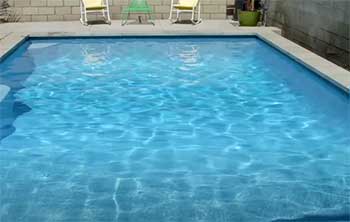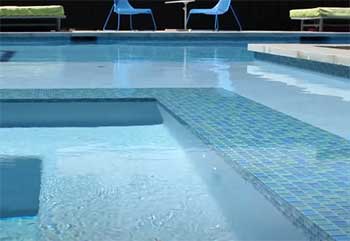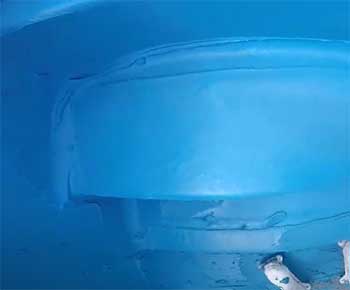Hydrazzo has become one of the most popular pool finishes in recent years. This pebble-like material is attractive, durable, and adds value to your pool.
However, no finish is without its flaws. Here’s a deep dive into the most common Hydrazzo pool finish problems homeowners face.
Common Hydrazzo Pool Finish Problems
While Hydrazzo is more durable than standard plaster, it is still susceptible to damage. The same issues that affect regular plaster can also deteriorate Hydrazzo. However, the pebble exposed nature of Hydrazzo leads to a few unique problems as well.
- Etching and Staining

One of the most prevalent issues with any pool plaster is staining and etching from chemicals.
Hydrazzo is no exception.
The smooth polished pebbles easily etch when the water chemistry drops out of balance.
Low pH and low alkalinity are usually the culprits behind etching and staining.
The acidic water leeches minerals from the Hydrazzo surface. Over time this causes roughness and corrosion of the pebbles.
Staining most often occurs from metal ions in the water. Copper and iron are particularly problematic. These metals oxidize and leave stubborn brown and green stains on Hydrazzo.
To avoid etching and staining, you must actively monitor and balance the pool water. Test pH and alkalinity weekly. Adjust with acid or sodium bicarbonate to keep levels in range. Also shock the pool regularly to destroy metals and other contaminants.
Catching chemical imbalances early minimizes damage. But even balanced water will slowly erode Hydrazzo over many years.
- Loss of Pebbles
Another common complaint is losing pebbles out of the Hydrazzo surface. This mainly occurs during the first year after installation. But pebbles can continue to pop out over time.
There are a few reasons pebbles become dislodged:
- Improper troweling during installation
- Damage from low pH etching the plaster behind pebbles
- Debris getting trapped behind pebbles from inadequate cleaning
- Freeze damage loosening pebbles in cold climates
Losing a few pebbles along the edges or high traffic areas is normal. But excessive loss indicates a bigger problem. Like etching, low pH is usually the root cause.
Catching pH issues quickly prevents damage and pebble loss. Handling the pool gently with brushes rather than vacuums also reduces pebbles getting knocked out.
- Rapid Color Loss

The variegated color of Hydrazzo provides its signature look.
But some homeowners report the vibrancy fading within the first year.
Rapid color loss leaves the pool looking drab and lackluster.
Again, poor water balance is often the culprit here. Low pH and alkalinity leech the pigment out of the exposed pebbles. The color dulls as minerals dissolve from the surface.
UV rays also contribute to fading. Some colors like blue are particularly prone to sunlight fading.
Using a weekly stain prevention product helps slow color loss. Maintaining proper water balance is key. Testing and adjusting pH, alkalinity, and calcium hardness prevents rapid deterioration.
- Rough Texture Over Time
The signature smooth, polished pebbles of Hydrazzo eventually lose their luster. Over years of exposure to pool chemicals and sunlight, the surface grows rough and uneven.
Etching from acidic water eats away at the polished finish. Some pockets will become rough and pitted while others remain smooth. The uneven erosion leads to a bumpy texture.
As Hydrazzo ages, the once luxurious pebbles feel more like sandpaper on bare feet. The only fix for complete roughness is resurfacing the pool.
To maximize the life of the smooth finish, monitor water chemistry closely. Brush rather than vacuum the pool. And use stain prevention products to slow erosion.
- Difficulty Matching Color for Repairs
Hydrazzo’s variegated colors come pre-blended from the manufacturer. If you ever need plaster repairs, it’s impossible to exactly match the original color.
The repainted area will stand out against the original Hydrazzo. The difference is glaring on single color Hydrazzo. Multi-color blends can somewhat mask patches. But the color mismatch is unavoidable.
Some owners choose to resurface entire pools rather than live with patchwork repairs. If repairs are needed, aim for the most subtle color difference possible. Inform homeowners of this issue before installing Hydrazzo.
- Higher Upfront Cost

The biggest downside for many homeowners is the high installation cost.
Hydrazzo runs $1-2 more per square foot compared to basic plaster.
That equates to thousands in extra costs for the average pool.
Labor makes up a large portion of the price.
It takes skill and time to evenly apply the pebbles in the plaster coat.
The extra steps also add costs compared to quick shooting with standard plaster.
For the natural stone look and longevity, the cost may be worthwhile. But budget-focused homeowners will be put off by the high initial investment.
- Longer Installation Time
In addition to the higher cost, Hydrazzo takes substantially longer to install correctly. The pebble application and troweling time significantly adds to the plastering duration.
Most standard plasters take just a day or two to complete. Hydrazzo usually takes at least double that time. This is frustrating for homeowners eager to start swimming.
The process cannot be easily rushed or corners cut. Proper troweling and smoothing is essential to prevent pebbles from releasing later on. Take the extra downtime into account when planning the project.
- Quick Color Saturation
The colorful Hydrazzo pebbles quickly leech pigment into the water. The water will become stained after just a few uses of the pool.
While not harmful, the colored water can be unappealing. It may give the impression of a dirty or unclean pool even when properly balanced.
Using a dose of stain and scale inhibitor when opening the pool helps. Running the filter for extended periods will clear the color. But frequent backwashing is required the first season.
Dealing with pigmented water is a minor annoyance. Chlorine will gradually bleach the pebbles and reduce coloring over time.
- Unsightly Organic Staining
Like any light plaster, Hydrazzo is prone to staining from organic matter like leaves, grass, and dirt. As debris decomposes in the pool, the pores in the finish absorb a stubborn grey or black stain.
These stains cannot easily be removed by shocking or brushing alone. Specific stain treatment chemicals are required to lift the stained top layer of plaster. Prevention by using covers and removing debris quickly is key. The more porous Hydrazzo absorbs stains faster than other plasters.
- Calcium Scaling on Pebble Surface
High calcium hardness combined with high pH leads to white scaling on Hydrazzo. The mineral deposits cake on the pebble surface, obstructing the shimmer and texture.
Acid washing is required to remove calcium scaling once formed. This procedure risks further etching the pebbles. Maintaining proper hardness and pH balance is crucial to prevent buildup on Hydrazzo.
- Fast Algae Growth in Rough Texture
The peaks and valleys of exposed pebbles are prime areas for algae to take hold and flourish. Once algae starts growing, the rough texture makes it harder to fully remove and kill.
Staying on top of chemical maintenance prevents algae from ever gaining a foothold. But Hydrazzo’s texture makes it more prone to rampant algae growth if conditions are right.
- Short Life Expectancy In Hot Climates
The warm temperatures of southern regions speed up erosion of Hydrazzo from chemical exposure. Etching and color loss happen twice as fast compared to northern pools.
In hot climates, the lifespan of Hydrazzo may be 6-8 years rather than over 10 years. This quicker deterioration should factor into the value proposition of the added cost.
- Difficulty Achieving Even Color Coverage
Hydrazzo’s speckled colors rely on even application of the pebbles in liquid plaster. Inexperienced builders often have blotchy or spotty coverage.
Maintaining A Hydrazzo Pool Finish
While Hydrazzo is prone to a few unique problems, you can maximize the lifespan with proper care. Here are key tips for maintaining Hydrazzo:
- Test and balance pH, alkalinity, and calcium weekly. Keep pH 7.2-7.6.
- Shock pool regularly to control metals and contaminants.
- Brush pool weekly to prevent debris behind pebbles.
- Use stain prevention products to slow color loss.
- Drain and clean pool fully each season.
- Winterize pool properly in cold climates.
- Avoid acidic cleaners which will etch the surface.
- Handle pool gently – do not scrape or vacuum aggressively.
With diligent water care and maintenance, your Hydrazzo finish can remain vibrant and smooth for over a decade. Address any chemical imbalances immediately before they ruin the polish.
Do You Still Want Hydrazzo For Your Pool?
Even with its potential drawbacks, Hydrazzo remains one of the most elegant and durable pool plasters available today. The problems above are manageable compared to the enjoyment a colorful Hydrazzo pool provides.
No finish is maintenance-free forever. With Hydrazzo’s proper care, you can maximize the lifespan and minimize etching or color loss. Weigh the benefits and drawbacks carefully for your pool project. For most homeowners, the elegance and luxury of Hydrazzo is worth the extra investment.
Hydrazzo Pool Finish FAQs
Here are answers to some frequently asked questions about Hydrazzo pool finish:
With proper care, Hydrazzo should last 8-12 years before needing resurfacing. Maintaining excellent water balance maximizes the lifespan up to 15+ years.
No, polishing Hydrazzo is not recommended. The pebbles are exposed and will be quickly damaged. Save your money for an eventual plaster replacement instead.
Durazzo is another popular pebble pool finish. The main differences are Durazzo has larger pebbles, rougher texture, set patterns, and more color customization. Durazzo is also more budget-friendly.
Hydrazzo offers a limited lifetime material warranty when installed by approved builders. This covers manufacturer defects, but normal wear and tear like etching are not covered. Labor is also only included for the first year.
Final Thoughts
Hydrazzo creates a beautiful and durable pool finish, but does come with some unique potential problems. Etching, staining, and color loss top the list, mainly driven by improper water chemistry.
The rough pebbled texture also provides challenges for cleaning and maintenance. With high upfront costs, these issues make Hydrazzo less than ideal for certain pools and climates.
For the right customer, the elegance and luxury of Hydrazzo outweighs the extra care required. Maintaining balanced water and vigilant cleaning maximizes the lifespan of this premium aggregate pool plaster.
With reasonable expectations, Hydrazzo creates a poolscape to envy for years to come.
